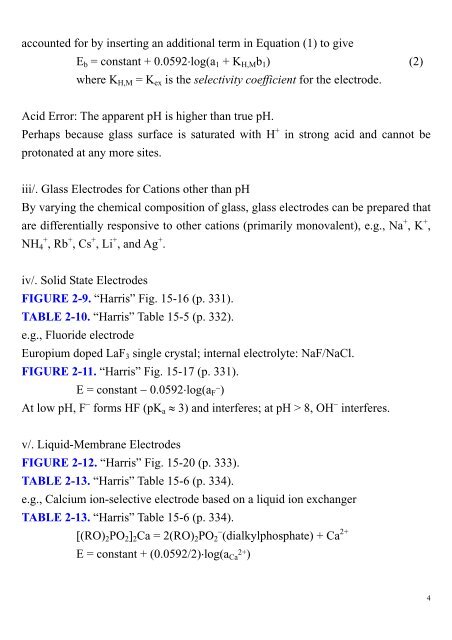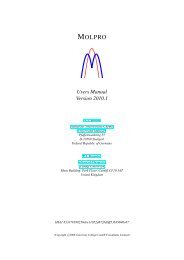CHAPTER II. POTENTIOMETRY AND REDOX TITRATIONS I ...
CHAPTER II. POTENTIOMETRY AND REDOX TITRATIONS I ...
CHAPTER II. POTENTIOMETRY AND REDOX TITRATIONS I ...
- No tags were found...
Create successful ePaper yourself
Turn your PDF publications into a flip-book with our unique Google optimized e-Paper software.
accounted for by inserting an additional term in Equation (1) to giveE b = constant + 0.0592⋅log(a 1 + K H,M b 1 ) (2)where K H,M = K ex is the selectivity coefficient for the electrode.Acid Error: The apparent pH is higher than true pH.Perhaps because glass surface is saturated with H + in strong acid and cannot beprotonated at any more sites.iii/. Glass Electrodes for Cations other than pHBy varying the chemical composition of glass, glass electrodes can be prepared thatare differentially responsive to other cations (primarily monovalent), e.g., Na + , K + ,NH + 4 , Rb + , Cs + , Li + , and Ag + .iv/. Solid State ElectrodesFIGURE 2-9. “Harris” Fig. 15-16 (p. 331).TABLE 2-10. “Harris” Table 15-5 (p. 332).e.g., Fluoride electrodeEuropium doped LaF 3 single crystal; internal electrolyte: NaF/NaCl.FIGURE 2-11. “Harris” Fig. 15-17 (p. 331).E = constant − 0.0592⋅log(a F− )At low pH, F − forms HF (pK a ≈ 3) and interferes; at pH > 8, OH − interferes.v/. Liquid-Membrane ElectrodesFIGURE 2-12. “Harris” Fig. 15-20 (p. 333).TABLE 2-13. “Harris” Table 15-6 (p. 334).e.g., Calcium ion-selective electrode based on a liquid ion exchangerTABLE 2-13. “Harris” Table 15-6 (p. 334).[(RO) 2 PO 2 ] 2 Ca = 2(RO) 2 PO − 2 (dialkylphosphate) + Ca 2+E = constant + (0.0592/2)⋅log(a 2+ Ca )4











![Hetero [6+3] Cycloaddition of Fulvenes with N-Alkylidene Glycine ...](https://img.yumpu.com/35423358/1/190x245/hetero-6-3-cycloaddition-of-fulvenes-with-n-alkylidene-glycine-.jpg?quality=85)




